The Fleischmann House
Architectural Description
Overview
Located in Peekskill, NY, the Fleischmann House is a two-story home designed for Gustav Fleischmann, Jr., by architect Chester A. Patterson. The house was built in 1927, and retains a high degree of historic integrity in its architectural design, local setting, construction materials, and workmanship. It is considered a prime example of Colonial Revival architecture, in which Patterson combined elements from multiple revival influences, including British Colonial, Dutch Colonial, French Colonial, and early Classical Revival. Architects such as Patterson also frequently exercised design interpretations mixing Georgian and Federal styles, which are seen in a number of the home's architectural details.

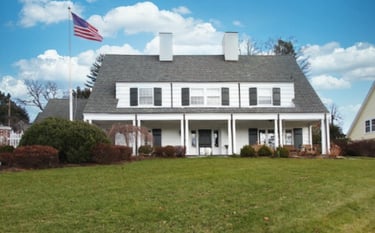
The interior living space measures approximately 4,100 square feet and includes a foyer, living room, dining room, ‘Pine Room,’ kitchen, breakfast room, flower room, butler’s pantry, five bedrooms, upstairs den, study, and six bathrooms. The home is located at the intersection of Riverview and Maple Avenues in the Mortgage Hill neighborhood. The lot measures approximately two-thirds of an acre, and the sloped front lawn is cultivated with beds of shrubs, evergreens, and roses. The rear of the house is terraced into three separate tiers of gardens, walled courtyards and fountains. The house’s historical integrity has been well maintained, as can be discerned by comparing images of the house as it stands today with the original blueprints from 1927.
Location & Setting
The house is located southeast of the city’s business district along the western boundary of a quiet, residential neighborhood facing west toward the Hudson River. The southwestern corner of the house is positioned at an eighty-foot setback line measured parallel to Maple Avenue. The property is fronted by a mortared uncut stone wall, and the front lawn is landscaped with evergreen and deciduous shrubs. The rear property is terraced into three separate tiers of gardens, courtyards and fountains. The lowest tier’s north and south courtyard gardens are separated by a veranda and fountain bordered by original brick walls with slate coping. The second tier is bounded by landscape timbers with a garden path running through it. The third tier is enclosed on the eastern boundary by a mortared uncut stone wall, and features an original concrete fountain / fish pond surrounded by yew hedges, roses, and perennial beds. The three terraced garden tiers are connected by original brick stairs with slate coping that are set into the hillside.


Exterior
The two-story Colonial Revival home was originally designed as a linear plan with a side gabled roof; however, an addition to the home in 1934 resulted in a rear-facing L-shaped plan with a cross-gabled roof in the rear.
West Elevation (Front)
Both the first and second levels of the front of the house are covered in white wood shingles with an 11” exposure. The first level is visually dominated by a full-width porch made of mortared slate, which offers expansive views of the Hudson Highlands, including Bear Mountain and Dunderburg Mountain. as they rise above the Hudson River. Centered along the porch is an unglazed front door with six raised panels, flanked on both sides by narrow, intricately leaded sidelights above raised wood panels, which are bounded by full-height pilasters. On either side of these are two symmetrical pairs of French doors, each with ten lights that open onto the porch from the dining room on the north end, and from the living room on the south end. The French doors are flanked by hinged wooden shutters with a flower pot motif carved into the highest of three stacked raised panels. The shutters are held in their open position by S-shaped iron shutter dogs.
The front porch is covered by a beaded ceiling that is supported by 14 understated Temple of the Winds Corinthian columns with subtle acanthus leaves seated on square plinths. These are positioned beneath an entablature consisting of architrave, frieze, and cornice. The porch is overhung by the home’s moderately sloped roof, which has slightly flared eaves boxed with dentils.
Centered above the porch on the second level is a continuous shed dormer of four eight-over-eight double-hung windows. The middle two of the four windows are joined as a pair, while the outer two windows are positioned apart. They are set back into the roof and look out onto an architectural “deck.”
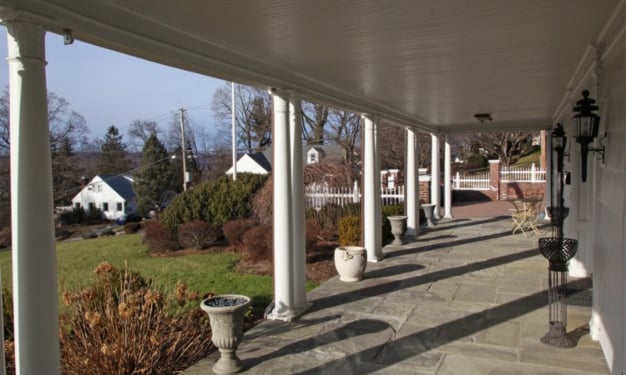

Copper gutters and leaders are used to catch rain water from the roof on all elevations. Blueprints for the original slate roof were prepared by the Vendor Slate Company. The original plans called for Metowee stone tiles; however, these were replaced with architectural shingles in 2001. Rising above the side-gabled roof are two prominent interior chimneys of identical proportions, clad in white stucco. The south chimney serves the living room fireplace, while the north chimney is false and was designed for purposes of visual balance and symmetry.
North Elevation (Side)
The first level of the north elevation is covered in colonial brick in a running bond, while the second level is clad in wood shingles with the same 11” exposure as the west elevation. The brick of the first level and shingles of the second level are divided by dentil molding that extends in a continuous run from the porch eave.
On both the first and second levels of the north elevation are a pair of eight-over-eight double-hung windows. Beneath each pair is an original nine-foot long, copper-lined window box for flowers, supported by wooden brackets. Directly beneath the first level’s window box is a below-grade window well and drain, covered by a hinged iron grate that provides access to a sash through which coal could be delivered to the basement’s coal room. At the top of the house, just below the peak of the side-gabled roof, is a lead glass oval attic window with 24 lights in a spiderweb design, mounted within an oval wood frame divided by four decorative keystones.
A recessed garage is attached to the north side of the house, with a secondary dropped roof positioned lower than that of the main house. The original hinged garage doors have been replaced by a retractable door mounted with suspension coils. Attached to the north side of the garage is an outdoor mortared staircase of 12 steps made of brick risers and bluestone treads that lead to a portico entrance to a room above the garage. The portico has its own dropped roof supported by wooden columns, with screened pigeonholes serving as gabled eave vents. A brick parking court adjacent to the garage is surrounded by brick walls and piers topped with decorative white pickets, and is accessible from a curved, paved driveway.
East Elevation (Rear)
The residential portion of the east elevation is clad in wood shingles on both the first and second levels. An entrance to the kitchen is centered on the first level, consisting of a glazed batten door with two-over-two lights. To the right of this door is a casement style bay window, which has replaced an original pair of double-hung sash looking out from the former pantry (now a breakfast room). Beneath this window is a below-grade window well and drain, covered by a hinged iron grate that provides access to a steel sash looking out from the basement’s laundry room. Further to the right is the rear brick wall of the attached garage, which includes two double-hung windows and a seven-foot long copper-lined window box for flowers. Further to the right is a small outdoor storage room beneath the elevated portico, accessible by a three-quarter height batten door.
Returning to the centered kitchen entrance, a pass-through dairy safe is built into the wall to the left of the doorway, just below a small two-over-two double-hung sash. To the left of this is a much larger, casement style bay window which has replaced the kitchen’s original pair of double-hung sash. An additional two-over-two double-hung sash is located further to the left, looking out from the former flower room (now a wet bar). Beneath these windows is a below-grade concrete staircase leading to a basement entrance that consists of a glazed door with four divided lights above two raised panels. The staircase is surrounded by a Chinese Chippendale railing.
Above the kitchen on the second level are three pairs of six-over-six double-hung sash. These are set back into the roof, and overlook an architectural deck similar to the one found on the west elevation. However, unlike the front example, the rear deck originally featured a decorative Chinese Chippendale railing which has since been removed.
Extending out from the southeastern corner of the house is the rear-facing L-plan extension that was added to the home in 1934. It features three pairs of French doors that open onto an elongated bluestone step, with each door consisting of ten divided lights. The L-shaped addition is unusual in that only a portion of it contains a second level (with a pair of double-hung sash), while the remainder is topped by another architectural deck. However, this deck differs from the other two in that it is the only deck accessible from a doorway inside the house, rather than from a window. Rising above the L-plan extension is a cross-gabled roof and the house’s third chimney, clad in the same stucco as the other two chimneys that are visible from the west elevation.
South Elevation (Side)
The south side of the house includes both the southern end of the home’s original 1927 linear design, as well as the L-plan extension added in 1934. Like most of the rest of the house, it is clad in shingles with an 11” exposure. The first and second levels are divided by a decorative strip of dentil molding that extends in a continuous run from the porch eave. The first level of the 1934 extension includes a particularly large bay window that looks out from the ‘Pine Room’ den, and consists of four double-hung sash that include two centered six-over-six windows, and two side eight-over-eight windows. To the left is another large bay window that looks out from the living room, and consists of four double-hung sash that include two centered six-over-six windows, and two side four-over-four windows. Both bay windows are capped with the same entablature found on the front porch, consisting of architrave, frieze, and cornice. On either side of the living room’s bay window are below-grade window wells and drains with hinged iron grates that provide access to steel windows that can be opened from within the home’s enclosed crawl space.
The second story includes an architectural deck, and two double-hung windows of six-over-six lights that look out from a second master bathroom added in 1934. To the left are three double-hung windows consisting of eight-over-eight lights each that look out from the master bedroom. Even further to the left and indented into the roof is an unusual, small roundel that emits light into the master bathroom’s shower. At the top of the house, just below the peak of the side-gabled roof, is a lead glass swiveling attic window with 24 lights, mounted within an oval wood frame divided by four decorative keystones. This window is identical to the attic window on the opposing north elevation.
Interior
The interior of the home consists of approximately 4,100 square feet of living area divided between two levels, in addition to a full basement and walk-up attic.
Basement
The approximately 1,000 square foot basement is accessible inside the house by a staircase just off the kitchen, and also from a below-grade exterior staircase and entrance in the rear of the house. The basement includes a laundry room, pressing closet, passage way, boiler room, coal room, storage room, and half bathroom. The foundation consists of poured concrete, and the floors are made of cement. The ceiling consists of metal lath and cement covered in plaster. A dwarf wall in the boiler room provides access to an elevated, enclosed crawl space beneath a portion of the first level. Of interest is an original Pneumerkator kerosene tank gauge mounted to the basement wall, which was used to monitor the amount of fuel on hand to service the home’s gas lights. The home’s original plumbing and heating infrastructure was installed by W. J. Donavan, Inc.
First Level
The interior of the 2,100 square foot first floor includes a large front foyer with a dining room entrance to the left, a staircase to the second level opposite the front entrance, a doorway to the kitchen off the stairway landing, entrances to a vanity and powder room to the right of the staircase, and a living room entrance further to the right. Beyond these rooms are the downstairs den known as the ‘Pine Room,’ flower room (now a wet bar), kitchen, butler’s pantry, and large storage pantry (now a breakfast room). The first level consists of hardwood floors throughout, with the exception of simulated wood linoleum floors in the kitchen, butler’s pantry and wet bar. High baseboards at the bottom of the walls and crown molding at the top of the walls are found in every room of the house.
Living Room: On the right side of the foyer is a pair of stately paneled doors with filigree hardware that form the entrance to the home’s living room. It includes a fireplace with tiled hearth, wooden mantel with hand-painted details; a built-in bookcase on the north wall; and an expansive bay window comprised of 40 lights and a window seat positioned over trimmed wall panels on the opposing southern wall. Four French doors with a total of 40 divided lights are positioned on the western wall leading out onto the home’s front porch. Hinged exterior storms can be opened and replaced with seasonal screen doors that are still stored in the attic. The room’s walls and ceilings are joined by wood crown molding.
Pine Room: On the living room’s eastern wall are four paneled doors leading to the family den which was added in 1934. When the home was originally built in 1927 it included an enclosed rear porch in this area, but seven years later the Fleischmanns engaged local builder Everett Young of the Cameron Construction Company to reconstruct the enclosure as an indoor 650 square foot den that became known as the ‘Pine Room.’ Used as the family’s gathering space and to entertain friends, business associates and civic leaders, the expansive room is finished with richly stained knotty pine panels. These feature three pairs of fluted pilasters positioned above plinths in low relief, topped by florette medallions.
The room’s north-facing wall is anchored by a large fireplace and tiled hearth with an American eagle surrounded by reeding positioned beneath the wide mantel piece. On either side of the fireplace are built-in bookcases topped with a curved arch. On the opposing southern wall is an expansive bay window with 56 divided lights looking out onto a walled courtyard garden. On the eastern wall are three pairs of French doors with a total of 60 divided lights that lead out into the rear gardens and a brick and stone staircase built into the corresponding hillside. The ceiling is supported by two pine beams running north to south. The hardwood floors are different from those found elsewhere in the house, in that they are notably wider and are adjoined to a wooden subfloor with plugged screws, rather than tongue-and-groove construction. The room’s radiators are built into the walls and enclosed with vented wood panels and brass colored grates.
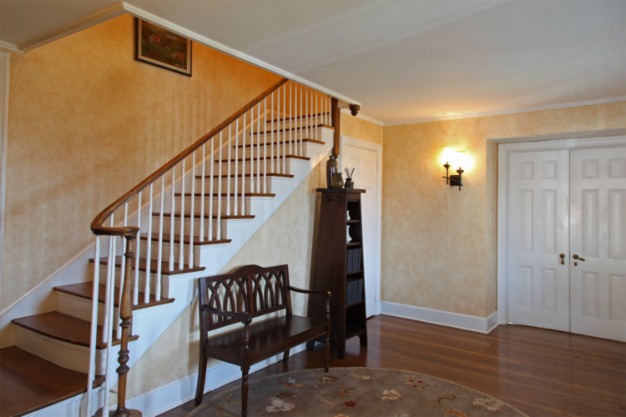

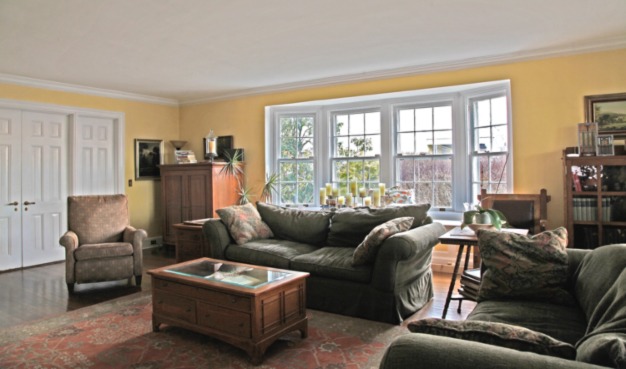

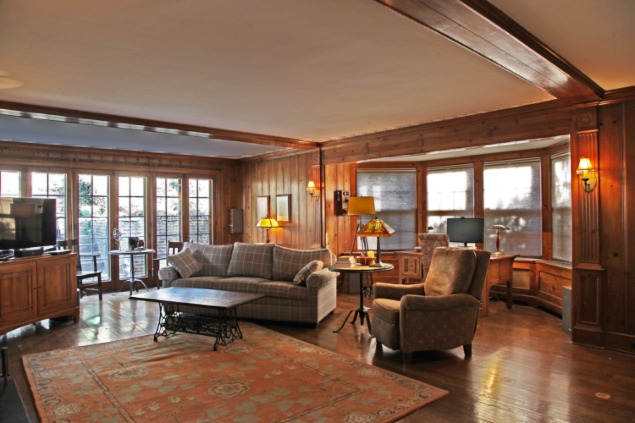

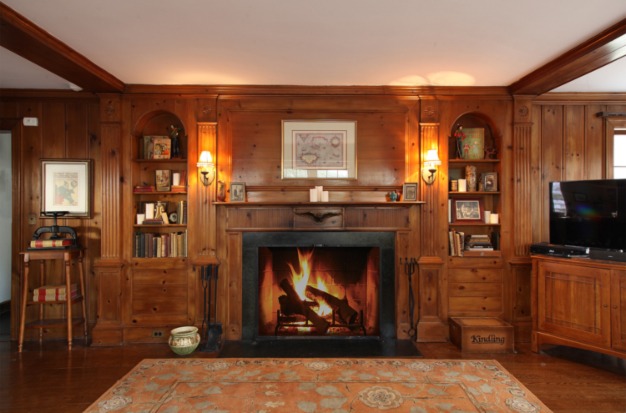

Flower Room / Wet Bar: On the north wall of the Pine Room is an entrance to the original flower room, which is now a wet bar with original cabinetry, copper sink and nickel faucet in the shape of a swan’s head. A small double-hung sash looks out onto one of the rear courtyards.
Kitchen: A doorway from the original flower room provides a segue to the kitchen, which has been remodeled several times since its original construction. Its most recent remodeling in 2014 was intended to return the design to an aesthetic more fitting for the home’s original 1927 construction, and is comprised of simple colonial style white cabinets, white and gray quartz counters, and subway tiles on the walls. The kitchen’s original double-hung windows were previously replaced by a large casement style bay window. The floor is finished in linoleum strips with the appearance of dark hardwood, and the kitchen’s walls and ceilings are joined by wood crown molding. The kitchen has a small vestibule and rear exterior entrance to the house that adjoins the courtyard and gardens.
Butler’s Pantry and Breakfast Room: The north wall of the kitchen gives way to a butler’s pantry with counters and cabinets. Beyond this room is an original storage pantry which now serves as a breakfast room. The original wall-mounted cabinets were removed long ago, and the original pair of east-facing double-hung windows were replaced by a casement style bay window. An original pantry sink beneath the window was replaced by an iron radiator. The walls have been trimmed with a wraparound chair rail, and wood crown molding joins the walls with the ceiling. A bell call box with a room number display for paging domestic staff is still mounted to the north wall. The west wall of the pantry gives way to an intersection comprised of an entrance to the 430 square foot garage on the right, a rear staircase to the domestic staff’s quarters on the left, and an entrance to the dining room straight ahead.
Dining Room: The family dining room is a brightly lit space that includes two double-hung windows on the north wall looking out onto the parking court, and two pairs of French doors on the west wall that open onto the front porch, overlooking Dunderburg and Bear Mountains on the western shore of the Hudson River. The French doors include exterior hinged storms that can be opened or replaced with seasonal screen doors. The walls and ceiling are joined by elaborate wood and plaster crown molding of a leaf-and-dart design.
Foyer, Closet, Vanity and Lavatory: The south wall of the dining room includes two paneled doors that open onto the front foyer, where a staircase leads to the second floor. Beneath the staircase is a coat closet, vanity, and lavatory. The commode is still operated by a large brass push button mounted to the wall, and a louvered ceiling vent can be opened or closed with suspended cords. The gold-plated sink is set into a dark green marble slab that matches the marble tiled floor. Above the sink is a three-way hinged mirror.
Second Level
Front Staircase: The 2,000 square foot second floor is accessible from a staircase in the foyer, with a spiraled handrail supported by spindles and attenuated newel posts at the bottom and top of the stairs, two of which are punctuated with drop finials. The stairway leads to a mezzanine hallway with entrances to the master suite, two additional bedrooms, a linen closet, and an entrance to the former household staff’s wing. Hardwood floors are used throughout the second level, with the exception of tiled bathroom floors, and simulated wood linoleum floors in the upstairs den.
Master Suite: The master bedroom includes two double-hung windows on the south wall. A closet with full-length mirror is found on the east wall, and another closet is located on the north wall. The east wall formerly included two gas light fixtures which have been removed and capped. The plaster walls are joined to the ceiling with crown molding, beneath which is situated a picture rail. An open, wide entrance to a small study or sitting room is found on the south wall. It includes two narrow built-in bookcases and a double-hung window looking out toward the Hudson River. Adjacent to the study is the original master bathroom, which includes a bathtub and a separate shower with overhead faucet and two wall-mounted directional faucets. Original tile floors and fixtures are still in use. Opposite the original bathroom on the bedroom’s north wall is an entrance to a dressing room and second master bathroom added in 1934. The dressing room includes three side-by-side closet doors with full length mirrors; inside the right side closet is a built-in combination safe. Adjacent to the closets on the west wall is a built-in vanity table with drawers, above which are three wall-mounted mirrors. While the center mirror is stationary, the left and right mirrors are hinged and can be opened to reveal shallow cabinets. Opposite the closets on the north wall are two double-hung windows with interior shutters, and on the east paneled wall is an entrance to a second master bathroom. A decoratively framed bathtub with basket-handle arch, keystone, and pilasters is set into the north wall. It is flanked by closets on either side, one of which includes a second built-in combination safe. Opposite the tub on the south wall are two double-hung windows with interior shutters. The trim paneled walls are joined to the ceiling with crown molding. The east wall includes a paneled door leading to an outdoor deck.
Child/Guest Bedrooms and Bathroom: Two other bedrooms and another bathroom are accessible from the master suite’s sitting room via inner-connecting doors, and also from the mezzanine hallway. Each of these bedrooms includes a closet, a pair of double-hung windows, hardwood floors, high baseboards, and crown molding. One of the closets still includes a turn handle for adjusting the amount of fuel provided to the room’s former gas light fixtures, which have been removed and capped. The two bedrooms are connected by a shared bathroom with original tiled floor and partially tiled walls. Gustav and Marion Fleischmann had one child, a son named Gustav Fleischmann III, who occupied one of these bedrooms until he joined the U.S. Navy in World War II.
Household Staff Quarters: The former domestic staff’s wing is accessible from an entrance at the end of the mezzanine hallway, as well as from a rear staircase on the north side of the house. The staff’s quarters include two bedrooms, each with a pair of double-hung windows, a clothes closet, hardwood floors and plaster walls adjoining the ceiling with crown molding. A bathroom and adjacent utility closet (now an upstairs laundry room) separate the two bedrooms along the hallway. The back bedroom provides an interior entrance to what was originally a storage room above the garage (now an upstairs den), which can also be accessed from an exterior brick and stone staircase off the parking court.
Attic: A staircase leads from the staff quarters to the attic, where the visible framing of the roof consists of a center ridge board with common rafters joined by tie beams, and a queen post rafter trussing system. The attic’s construction gives a twist to the notion of “locally sourced materials,” as some of the support beams are stenciled with the Fleischmann Company’s name, indicating they were sourced through the local plant’s construction department. Leaded oval attic windows are situated just below the roof peaks in both the north and south sides of the house.